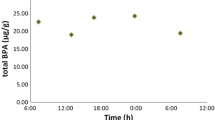Abstract
Objectives: We studied the range in urinary levels of 2-thiothiazolidine-4-carboxyl acid (TTCA), a metabolite of CS2 and phthalic acid (PA), a common metabolite of phthalates, across factories and departments in the contemporary rubber manufacturing industry. Methods: Spot urine samples from 101 rubber workers employed in nine different factories were collected on Sunday and during the workweek on Tuesday, Wednesday and Thursday at ∼4 pm. In total, 386 urine samples were successfully analyzed. Results: Levels of both biomarkers increased significantly by a factor 2 (paired t-test P-value <0.05) during the working week as compared to the Sunday biomarker levels with absolute increases of approximately 70 μg/l and 5 μmol/mol creatinine for PA and TTCA, respectively. Levels in both biomarkers did not differ markedly between working days. Increases seemed to be restricted to specific factories and/or departments (e.g. molding and curing). Conclusions: The results of this study demonstrate that rubber workers in the contemporary rubber industry are exposed to phthalates and low levels of CS2 (∼0.05 ppm) as measured by PA and TTCA, respectively. Exposures to both compounds are largely driven by specific circumstances in factories. Therefore, when estimating exposures to phthalates and CS2 detailed information should be collected on the type and amount of phthalate containing ester plasticizers, dithiocarbamates and thiurams used. Preferably, personal exposure data should be collected. In this case, biological monitoring seems a reasonable approach. However, in the case of PA attention should be given to individual background levels as this could lead to a substantial overestimation of the occupational contribution to total phthalate exposure.
Similar content being viewed by others
References
ACGIH (2002) TLVs and BEIs; threshold limit values for chemical substances and physical agents and biological exposure indices. Cincinnati, US, American Conference of Governmental Industrial Hygienist
Albro PW, Jordan S, Corbett JT, Schroeder JL (1984) Determination of total phthalate in urine by gas chromatography. Anal Chem 56:247–250
Blount BC, Silva MJ, Caudill SP, Needham LL, Pirkle JL, Sampson EJ, Lucier GW, Jackson RJ, Brock JW (2000) Levels of seven urinary phthalate metabolites in a human reference population. Environ Health Perspect 108:979–982
Danilenko LP, Kozintseva PV (1989) Prevention of nervous system diseases in workers manufacturing rubber products. Vrach Delo 3:109–110
Delpech MA (1863) Industrie de caoutchouc souffle. Reserche sur l’intoxication special que determine le sulfure de carbone. Ann d’Hygiene Publique 19:65–183
Duty SM, Silva MJ, Barr DB, Brock JW, Ryan L, Chen Z, Herrick RF, Christiani DC, Hauser R (2003) Phthalate exposure and human semen parameters. Epidemiology 14:269–277
Figa-Talamanca I (1984) Spontaneous abortions among female industrial workers. Int Arch Occup Environ Health 54:163–171
Graham DG, Amarnath V, Valentine WM, Pyle SJ, Anthony DC (1995) Pathogenetic studies of hexane and carbon disulfide neurotoxicity. Crit Rev Toxicol 25:91–112
Hornung R, Reed LD (1990) Estimation of average concentration in the presence of nondetectable values. Appl Occup Environ Hyg 5:46–51
Johnson DJ, Graham DG, Amarnath V, Amarnath K, Valentine WM (1996) The measurement of 2-thiothiazolidine-4-carboxylic acid as an index of the in vivo release of CS2 by dithiocarbamates. Chem Res Toxicol 9:910–916
Kato K, Silva MJ, Needham LL, Calafat AM (2005) Determination of total phthalates in urine by isotope-dilution liquid chromatography-tandem mass spectrometry. J Chromatogr B Analyt Technol Biomed Life Sci 814:355–360
Kenny LC, Aitken R, Chalmers C, Fabries JF, Gonzalez FE, Kromhout H, Liden G, Mark D, Riediger G, Prodi V (1997) A collaborative European study of personal inhalable aerosol sampler performance. Ann Occup Hyg 41:135–153
Kivisto H (2000) TTCA measurements in biomonitoring of low-level exposure to carbon disulphide. Int Arch Occup Environ Health 2000 73:263–269
Kromhout H, Swuste P, Boleij JS (1994) Empirical modelling of chemical exposure in the rubber-manufacturing industry. Ann Occup Hyg 38:3–22
Mikoczy Z, Hagmar L, Bergendorf U, Jakobsson K (2004a) Mortality and cancer incidence in the Swedish rubber industry. EPICOH; Reducing The Global Burden Of Occupational Disease& Injury, Melbourne
Mikoczy Z, Hagmar L, Jakobsson K (2004b) Reproductive outcome among Swedish rubber industry employers. EPICOH; Reducing The Global Burden Of Occupational Disease& Injury, Melbourne
NIOSH (1977) Manual of analytical methods, 2nd edn. Cincinnati, OH, U.S. Department of Health, Education and Welfare, pp 77–157-A
Roth VS (1999) Rubber industry epidemiology. Occup Med 14:849–856
Silva MJ, Barr DB, Reidy JA, Malek NA, Hodge CC, Caudill SP, Brock JW, Needham LL, Calafat AM (2004) Urinary levels of seven phthalate metabolites in the US population from the National Health and Nutrition Examination Survey (NHANES) 1999–2000. Environ Health Perspect 112:331–338
Vermeulen R, de Hartog J, Swuste P, Kromhout H (2000a) Trends in exposure to inhalable particulate and dermal contamination in the rubber manufacturing industry: effectiveness of control measures implemented over a nine-year period. Ann Occup Hyg 44:343–354
Vermeulen R, Kromhout H, Bruynzeel DP, de Boer EM (2000b) Ascertainment of hand dermatitis using a symptom-based questionnaire; applicability in an industrial population. Contact Dermatitis 42:202–206
Vermeulen R, Bos RP, Kromhout H (2001) Mutagenic exposure in the rubber manufacturing industry: an industry wide survey. Mutat Res 490:27–34
Acknowledgements
We would like to thank the employers and employees in the rubber manufacturing industry for the close co-operation in this study. We also would like to acknowledge Ms Å sa Amilon for skilful technical assistance. The study was partially supported by the AFA Foundation, the Swedish Research Council, the Swedish Governmental Funding for Clinical Research and the Medical Faculty of Lund University.
Author information
Authors and Affiliations
Corresponding author
Rights and permissions
About this article
Cite this article
Vermeulen, R., Jönsson, B.A.G., Lindh, C.H. et al. Biological monitoring of carbon disulphide and phthalate exposure in the contemporary rubber industry. Int Arch Occup Environ Health 78, 663–669 (2005). https://doi.org/10.1007/s00420-005-0017-z
Received:
Accepted:
Published:
Issue Date:
DOI: https://doi.org/10.1007/s00420-005-0017-z




